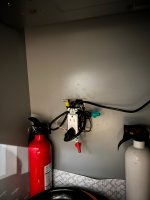mark32
Senior Member
- Location
- Currently in NJ
Hello all,
So, I've been doing work for an acquaintance, and during my last visit he told me he had gotten a shock while he was taking a shower. The background is, he bought the house last year and he hired a friend of a friend to renovate a few areas of the residence, including the bathroom/shower in question. This shower is in the guest bathroom, so there is normally no need for his family to use this shower, thus the reason this issue wasn't a high priority for him.
The faucet and drain strainer are metal, the floor of the shower is tile. There is a gfi serving the sink, so I get 120v from the gfi to the faucets, but not to the drain, and he'll only get this shock when the floor is wet. Some more observations, and my observation is the guy that did the wiring had little electrical knowledge and experience as his work was very messy and he had cut the egc off of the romex at the recessed lights in the bathroom. Most of the new circuits he pulled came from a sub panel, in which he had both the neutrals and egc's together, of course, and the hot water heater pipes were not bonded together either. (For the heck of it, I recorded a 2.5 amp draw on the GEC going to the water main)
To continue, I noticed my non-contact voltage tester would light up when I placed it near the faucet, so I hit all the single pole breakers as the homeowner held it in place, the tester didn't go off until I hit a double pole 30. This circuit fed a double oven/microwave which is in the kitchen that this bathroom borders (The guy had put a twist lock directly onto the four conductors emerging from the flex coming off this appliance) I then discovered that this unit was fed with a 10/2, hmm, so I would have opened the box the twist lock was plugged into to investigate, but I couldn't because the cabinet was installed over the box, so now there's like a 2" hole over the box so it can be plugged in
It was getting late so I had to pack it in, but I plan on going back maybe this coming week. I've been busy with other things, but one thing I thought was maybe a screw or nail went through the romex, (And hitting the ground) when the shower floor was put in, and because the neutral loads from the oven/micro are likely attached to the EGC (Because he ran a 10/2) thus in turn energizing the wire mesh for the shower floor, maybe? Would that cause a shock?
Ps, scratch that, a nail or screw going through this cable would've also hit either of the other two ungrounded conductors and shorting the circuit out.
So, I've been doing work for an acquaintance, and during my last visit he told me he had gotten a shock while he was taking a shower. The background is, he bought the house last year and he hired a friend of a friend to renovate a few areas of the residence, including the bathroom/shower in question. This shower is in the guest bathroom, so there is normally no need for his family to use this shower, thus the reason this issue wasn't a high priority for him.
The faucet and drain strainer are metal, the floor of the shower is tile. There is a gfi serving the sink, so I get 120v from the gfi to the faucets, but not to the drain, and he'll only get this shock when the floor is wet. Some more observations, and my observation is the guy that did the wiring had little electrical knowledge and experience as his work was very messy and he had cut the egc off of the romex at the recessed lights in the bathroom. Most of the new circuits he pulled came from a sub panel, in which he had both the neutrals and egc's together, of course, and the hot water heater pipes were not bonded together either. (For the heck of it, I recorded a 2.5 amp draw on the GEC going to the water main)
To continue, I noticed my non-contact voltage tester would light up when I placed it near the faucet, so I hit all the single pole breakers as the homeowner held it in place, the tester didn't go off until I hit a double pole 30. This circuit fed a double oven/microwave which is in the kitchen that this bathroom borders (The guy had put a twist lock directly onto the four conductors emerging from the flex coming off this appliance) I then discovered that this unit was fed with a 10/2, hmm, so I would have opened the box the twist lock was plugged into to investigate, but I couldn't because the cabinet was installed over the box, so now there's like a 2" hole over the box so it can be plugged in
It was getting late so I had to pack it in, but I plan on going back maybe this coming week. I've been busy with other things, but one thing I thought was maybe a screw or nail went through the romex, (And hitting the ground) when the shower floor was put in, and because the neutral loads from the oven/micro are likely attached to the EGC (Because he ran a 10/2) thus in turn energizing the wire mesh for the shower floor, maybe? Would that cause a shock?
Ps, scratch that, a nail or screw going through this cable would've also hit either of the other two ungrounded conductors and shorting the circuit out.
Last edited by a moderator:



